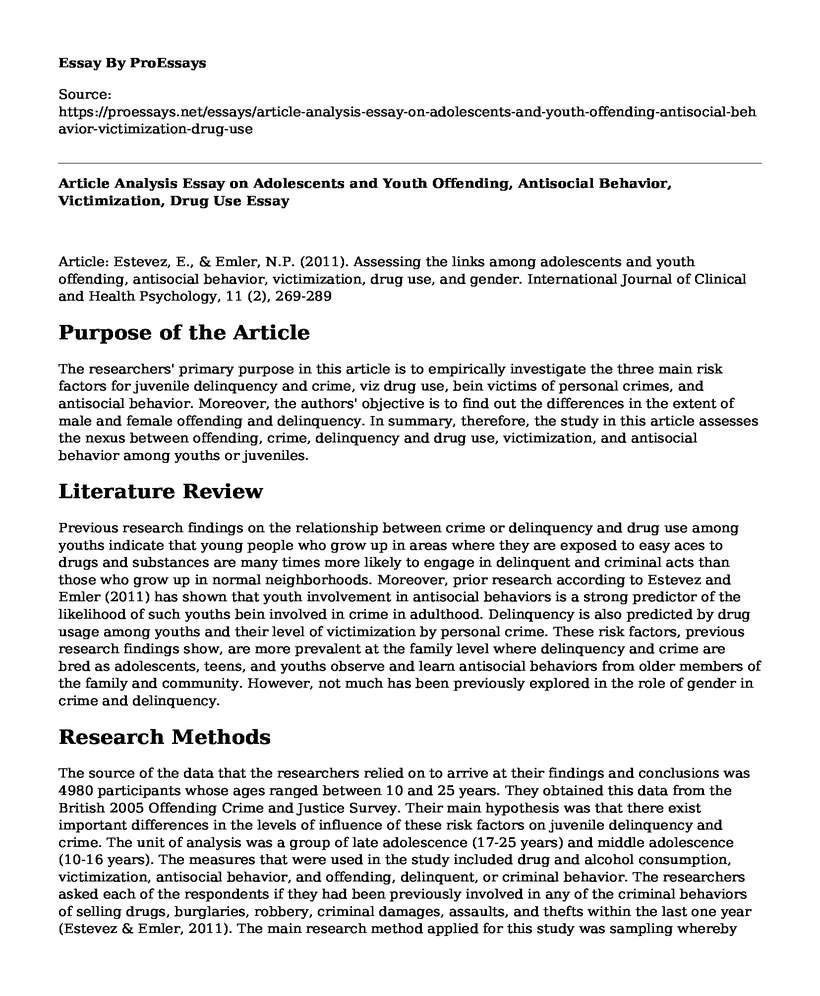Article: Estevez, E., & Emler, N.P. (2011). Assessing the links among adolescents and youth offending, antisocial behavior, victimization, drug use, and gender. International Journal of Clinical and Health Psychology, 11 (2), 269-289
Purpose of the Article
The researchers' primary purpose in this article is to empirically investigate the three main risk factors for juvenile delinquency and crime, viz drug use, bein victims of personal crimes, and antisocial behavior. Moreover, the authors' objective is to find out the differences in the extent of male and female offending and delinquency. In summary, therefore, the study in this article assesses the nexus between offending, crime, delinquency and drug use, victimization, and antisocial behavior among youths or juveniles.
Literature Review
Previous research findings on the relationship between crime or delinquency and drug use among youths indicate that young people who grow up in areas where they are exposed to easy aces to drugs and substances are many times more likely to engage in delinquent and criminal acts than those who grow up in normal neighborhoods. Moreover, prior research according to Estevez and Emler (2011) has shown that youth involvement in antisocial behaviors is a strong predictor of the likelihood of such youths bein involved in crime in adulthood. Delinquency is also predicted by drug usage among youths and their level of victimization by personal crime. These risk factors, previous research findings show, are more prevalent at the family level where delinquency and crime are bred as adolescents, teens, and youths observe and learn antisocial behaviors from older members of the family and community. However, not much has been previously explored in the role of gender in crime and delinquency.
Research Methods
The source of the data that the researchers relied on to arrive at their findings and conclusions was 4980 participants whose ages ranged between 10 and 25 years. They obtained this data from the British 2005 Offending Crime and Justice Survey. Their main hypothesis was that there exist important differences in the levels of influence of these risk factors on juvenile delinquency and crime. The unit of analysis was a group of late adolescence (17-25 years) and middle adolescence (10-16 years). The measures that were used in the study included drug and alcohol consumption, victimization, antisocial behavior, and offending, delinquent, or criminal behavior. The researchers asked each of the respondents if they had been previously involved in any of the criminal behaviors of selling drugs, burglaries, robbery, criminal damages, assaults, and thefts within the last one year (Estevez & Emler, 2011). The main research method applied for this study was sampling whereby participants were selected to represent the general population of juveniles. The researchers then conducted preliminary descriptive analyses of the data obtained from both male and female offenders, calculated, and tabulated the percentages of involvement in criminal and delinquent activities. Further to this, they carried out bivariate correlational analyses of the variables under study to better understand the connections between delinquency, crime, and risk factors. In doing the analyses of the interactions between variables, the researchers used the SPSS program, AMOS software version 4.0.
Results
One of the main findings of the study was that there is a significant correlation between drug use, victimization and criminal offending or delinquent behavior for youths between the ages of 10 and 25. The study also found these to be the risk factors of offending among juveniles. However, regarding gender as a variable, the study found that male gender was more associated with delinquent and criminal behavior than the female gender.
Discussion
In conclusion, these researchers' findings confirm previous research findings concerning the influence of victimization, age, gender, drug use, and antisocial behavior on crime and delinquency. However, the author's thoughts on what should be done for future research is that there is a need for further investigation and clarification of whether these findings would be replicated in different cultures. Their study indicates that the key to preventing juvenile delinquency and crime in societies is through the protection of youths from involvement in drug abuse, antisocial behaviors, and victimization.
Reference
Estevez, E., & Emler, N.P. (2011). Assessing the links among adolescents and youth offending, antisocial behavior, victimization, drug use, and gender. International Journal of Clinical and Health Psychology, 11 (2), 269-289.
Cite this page
Article Analysis Essay on Adolescents and Youth Offending, Antisocial Behavior, Victimization, Drug Use. (2023, May 12). Retrieved from https://proessays.net/essays/article-analysis-essay-on-adolescents-and-youth-offending-antisocial-behavior-victimization-drug-use
If you are the original author of this essay and no longer wish to have it published on the ProEssays website, please click below to request its removal:
- Paper Example on Burnout and PTSD
- Paper Example on Corporal Punishment and Child Abuse
- Adolescent Suicide: Ethics in Nursing Essay Example
- Asian Americans: The Model Minority in the 1960s Immigration Movement - Essay Sample
- Essay Example on Virtual Police Dept. Mobilizes to Stop Notorious VBBC Gang
- Paper Sample on Parent-Only Treatment Effective for Childhood Obesity: A Randomized Controlled Trial
- Paper Sample on Immigration to the U.S.: Detention and Discrimination of Foreigners







